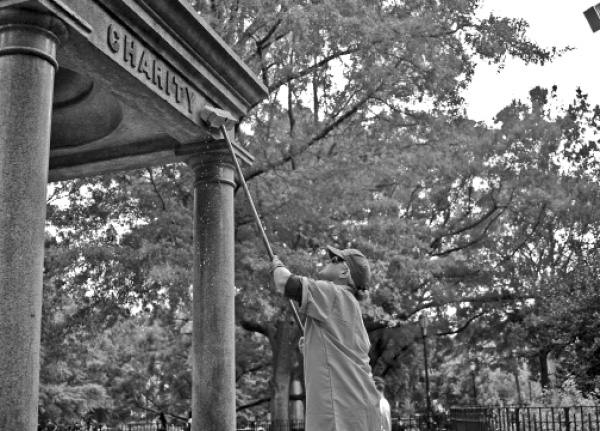
CLEAN DRINKING WATER
first performed on September 16, 2017
Temperance Fountain Plaza, Tompkin's Square Park, New York, NY
performed once in 2017
KATE CONROY
New York, NY
kateconroy.com
CLEAN DRINKING WATER
KATE CONROY
“Clean Drinking Water,” sited at Tompkin’s Square Park’s Temperance Fountain Plaza was a one-hour performance. I dressed in janitorial gear opened the performance by broom sweeping the plaza area. Then, after I cordoned off the area with caution tape and set in place “Clean Drinking Water” signs, I used soap water and a scrub brush to clean the fountain kiosk, including the fountain’s four virtue mantels: HOPE, FAITH, CHARITY, and TEMPERANCE. As a finale, I cleared the drain line, using a plumber’s snake through the base of the fountain to allow murky standing water to drain from its basin.
My janitorial gear semiotically names me as “Cleaner.” The caution tape is a warning to be careful with drinking water. “Clean Drinking Water” plays with language in its command (verb) to clean drinking water, while it also describes preferred state of (adj./noun) clean /drinking water. Visual and literary puns are a hallmark of my work. Park-goers and other passersby paused to appreciate, ponder, and engage.
The project is multi-purposed. It is a reclaiming of a Temperance Movement fountain whose original purpose was to provide drinking water as an alternative to drinking alcohol. This work also responds to Flint, Michigan’s lead-laden drinking water and an act of solidarity with Standing Rock and other water protectors who advocate for unpolluted drinking water. The work signals that our communities have clean water as long as we can protect it.
The project is also a reclaiming of Tompkins Square Park as a site for arts actions. The East Village is in the throes of hyper-gentrification and its newcomers have a dim or absent view of the arts and activism born in the neighborhood. As a three-decades-long resident of the East Village, my work reclaims a legacy that is threatened with erasure.
Finally, the Hebe statue serves as a finial atop the fountain kiosk on the plaza. The emblazoned virtues are of another time and might generally be considered feminine virtues. Together Hebe and I point out a social practice of women symbolizing nature (clean water) and women’s work as a necessity for instilling virtues (to not pollute) in the hearts and actions of capitalistic mankind.